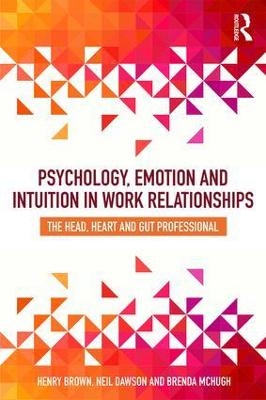
Psychology, Emotion and Intuition in Work Relationships
Routledge (Verlag)
978-1-138-30274-7 (ISBN)
Psychology, Emotion and Intuition in Work Relationships: The Head, Heart and Gut Professional highlights the increasing importance of human relations in professional life. In modern society, all those who work with or provide services to others are increasingly called upon to be not just technical experts, but also ‘head, heart and gut professionals’ – who can work and relate to others with their head, heart, and gut.
The book explains and synthesises these elements in an accessible way, based on a sound theoretical perspective combined with practical guidance. The authors address how to manage client expectations; how to deal with risk, uncertainty and imperfection, as well as how to improve communication and interpersonal skills. Attention is also given to the central role of empathy and rapport in professional relationships, while recognising the need for proper professional boundaries.
Psychology, Emotion and Intuition in Work Relationships will be a valuable guide for all modern practising and training professionals in a broad range of fields, including mental health, law, social and healthcare, teaching and academia, technology, financial and other services – indeed, for anyone who provides services and has working relationships of any kind.
Henry Brown, a retired solicitor, mediator and trainer, co-established a law firm in London, Waterloo and subsequently became a partner in a City of London firm. He co-founded and is a Vice-President of the Family Mediators Association and was Director of Mediation of the family lawyers’ organisation Resolution. Neil Dawson and Brenda McHugh are consultant systemic psychotherapists, lecturers and mediators. Having worked for over thirty years in child adolescent mental health services they are now programme directors at the Anna Freud National Centre for Children and Families where they have co-founded The Family School, London for children excluded from mainstream schools. They are internationally recognised trainers and have recently created an online training programme for mental health and school-based professionals.
Psychology, Emotions and Intuition in Work Relationships: The Head, Heart and Gut Professional
Contents Plan
1. On being a professional
The concept of "professional" in this work
A more effective professional role and understanding
The focus on substantive education and training
Gaining some understanding of the behaviour of others
Gaining some understanding about ourselves
What does the public expect from professionals?
Professional and personal authenticity
Professional jargon, mystification and patronisation
Conspiracy against the laity
The patronising professional
Client’s reactions and empowerment
Helping and healing professions
Defining the helping professions
Healing professions
The concept of the wounded healer
Further reading
2. Head, heart and gut:
Head – Brain and mind
Head, heart and gut in functioning and decision-making
The brain: central to understanding and functioning
Basic neuroscience: the brain and nervous system
Introduction to 100 billion neurons:
The nervous system
The human brain: old and new
The brain’s hemispheres: left and right brain
Two ways of thinking
Automatic processing
Conscious attentive processing
Intelligence
Some specialist views of the brain
The mindful brain
The social brain
The ethical brain
The spiritual brain
The mommy brain
The "new" brain
The mind
Further reading
3. Head, heart and gut:
Heart – Emotions
The heart as metaphor?
Cultural and biblical heritage
The heart’s physiological role in relation to the brain and emotions
Emotions and feelings
Emotional intelligence
Kinds of emotions
The purpose and effect of emotions
Feelings and consciousness
Emotions: reality and myths
The myth of rational decision-making
The myth that "negative emotions" are bad
The myth that "venting" an emotion will resolve it
The myth that women are emotional but men are not
Further relevance of emotions
Further reading
4. Head, heart and gut:
Gut – Intuition
Gut as metaphor
Intuition
What do we mean by intuition?
Everyday and expert intuition
A sixth sense?
Creative and predictive intuition
Complementary thinking
Heuristics
Intuition cautions
Availability error
The halo (and devil) effect
Framing effect
Fundamental attribution error
The representativeness heuristic
The overconfidence effect
Anchoring
Sunk costs fallacy
Some other factors and biases affecting intuition
Further reading
5. The hidden power of the unconscious
Don’t mention the war
Dagwood Bumstead and Basil Fawlty
Fundamental relevance of the unconscious
Freud’s unconscious
Jung’s collective unconscious and "shadow"
The cognitive approach
Freudian, Jungian or cognitive? What is this elusive unconscious? Does it even exist?
Some practical implications
Making decisions and choices: free will?
Intuition and "gut feelings"
Slips of the tongue and other errors
Body language (non-verbal communication)
Placebos and nocebos, Pygmalion and Rosenthal
Powerful and suppressed emotions distort effective functioning
Unconscious competence
Higher intuitions and inspiration
A springboard to other aspects
Further reading
6. The amygdala hijack: Triggers and strategies
The multiple roles of the amygdala
The amygdala hijack
Triggering the "amygdala hijack"
Fear
Panic
Anger
Shame and humiliation
21st Century multi-tasking
Rekindling amygdala hijack activators
Some strategies for dealing with amygdala hijack triggers
Empathy and compassion
Move off the topic causing distress
Support a shift into cognitive brain mode
Take a break
Deep breathing
Humour
Some longer-term strategies
Further reading
7. Understanding personality
The uniqueness of personality
Lord Scrutton’s elephant
The relevance of personality
Personality types and traits
Big Five
Myers Briggs Type Indicator (MBTI)
Contradictions in traits and preferences
Other personality tests
Personality disorders and traits
DSM-5 and other classifications
Maladaptive personality traits
Personality development
Cultural influences on behaviour patterns
Linear-active and multi-active
Cultural norms
Nature or nurture?
Some practical implications
Self-awareness
Relating to clients, patients, co-workers and others
Identifying and working with troubled personalities
The well-rounded professional
Further reading
8. Empathy, attunement and professional boundaries
Empathy: The essence of professional and personal relationships
Empathy and evolution
Empathy and sympathy
Empathy and rapport
Empathy in a professional context
Empathy, compassion and humanity
Empathy and reflective function (mentalisation or "theory of mind")
"Against empathy"?
Attunement
Attunement between parent and child: attachment theory
Interpersonal adult attunement
Intrapersonal attunement
The basic neuroscience of empathy, attunement and attachment
Mirror neurons
Other parts of the brain affecting empathy and attunement
Neural development and attachment
Neurobiology
Professional boundaries
Boundaried empathy
Other professional boundaries
Personal-professional boundaries
Some final thoughts about boundaries
Further reading
9. Professional relationships and expectations
Expectations of professional relationships
Expectations about the professional personally
Expectations about the professional environment
Expectations about the work to be done
Managing clients’ expectations
The power of expectations
Client centredness (person-centredness)
Transference and countertransference
Transference
Countertransference
Authority, power, trust and dependence
Authority
Power
Trust
Dependence
Culture and gender
Culture
Gender
Further reading
10. Enhancing professional relationships: Communication and other interpersonal skills
Essential communication skills
Active listening
Observing non-verbal communications
Acknowledging
Helping people to hear
Summarising
Questioning
Reframing
Avoiding professional jargon and mystification
Some other interpersonal skills
Establishing rapport
Maintaining professional presence and professional energy
Managing clients’ expressions of emotions
Understanding the value and use of symbolism and metaphor
Some communication practicalities
Terms of engagement
Some practicalities concerning communications
Further reading
11. Balancing professional and systemic tensions
The essential tension of opposites
Conflict and change
Systems and change
Profession v. Business
Public professional persona v. private persona
Tradition v. change: challenging the system
Systems thinking
Challenging and changing systems
The value of tradition
The downside of tradition
Recognising and managing concerns about change
Other competing professional tensions
Work pressure v. need for self-care and leisure
Budgetary constraints v. quality of care
Leadership v. democratic decision-making
Professional v. personal values
Further reading
12. High conflict personalities
Understanding high conflict personalities
What is a high conflict personality and how does it manifest?
Why professionals might need to know about high conflict personalities
Why do some people have high conflict personalities?
Attachment disorganisation
Personality disorder
Maladaptive personality traits and systemic influence
Links between attachment, personality traits and disorders, and high conflict
Cautions and reservations
Strategies for professionals dealing with high conflict personalities
Boundaried empathy
Empathetic objectivity – or reason and compassion
Structure and records
Small steps
Proactivity
Dealing with a client’s "world view"
Helping with understandings and responses
Helping decision-making inhibited by strong emotions
Seeking third party support where appropriate
High conflict endings
Further reading
13. Difficult people
Raise your hand if you’re a difficult person
Everyone is crazy except thee and me – and sometimes I’m not too sure about thee
What do you mean "difficult"?
Why some people are difficult and some strategies for dealing with them
Cautionary introduction
High conflict personalities
Anger – overt or suppressed
Non-cooperation and passive aggression
Power and control – and Machiavellianism
Negativity
Ambivalence and indecision
Intolerance of other views
It’s the situation, stupid
Further reading
14. Uncertainty, risk and imperfection
Living with uncertainty
The discomfort of uncertainty
Black Swans
Coping with uncertainty
Superstition: illusory control over uncertainty
The relationship between uncertainty and risk
Risk assessment and management
Risk-benefit analysis
Appreciating levels of risk and benefit
Complexity of risk measurement – decision trees
The considerable significance of subjective judgment
Prospect Theory
Risk tolerance and aversion
Imperfection
Striving for perfection
Living with imperfection
When imperfection constitutes professional negligence (malpractice)
Imperfection and paradox
Further reading
15. Negotiation
Negotiation fundamentals
To negotiate or not to negotiate – that is the question
Dealing with non-negotiable values
"Bargaining with the devil"
Negotiation approaches
Interest-based cooperative negotiation
Competitive negotiation
Reconciling interest-based and competitive approaches
Some practical aspects of negotiation
Preparation, design and set-up
Zone of (Possible) Agreement and the negotiation dance
The initial stages: anchoring
Continuing the negotiations
Some psychological aspects of negotiation
Emotions and the myth of rationality
Perceptions
Personality traits
Culture and gender in negotiation
Further reading
16. Conflict and disputes: management and resolution
Conflict and dispute outline
Distinguishing conflict and dispute
The paradox
Conflict
Dispute
Conflict resolution and management
Conflict resolution
Conflict management
Modes of responding to conflict
Dispute resolution: primary processes
Negotiation
Litigation – the court process
Religious courts
Alternative Dispute Resolution (ADR): Introduction
Non-adjudicatory ADR
Mediation (conciliation)
The mini-trial (Executive Tribunal)
Neutral case evaluation (Early neutral evaluation)
Adjudicatory ADR
Arbitration
Contractual adjudication
Dispute Boards
Expert determination
Administrative or statutory tribunals
Hybrid ADR processes
Med-arb (mediation-arbitration)
Arb-med (arbitration-mediation)
Neutral fact-finding expert
Ombudsman
Online dispute resolution (ODR)
Further reading
17. Beyond technique
Beyond technique: the concept
Self-nurturing and establishing calm
Meditation
Mindfulness
Yoga
Purpose and meaning
Earning a living
Making a difference
Having a sense of purpose and meaning
Expressing our humanity
Working holistically
Enhancing expertise and skill
Maintaining professional identity and self-esteem
Unconscious competence revisited
Further reading
18. Support needs and resources
Professional backup, teams and networks
Working in teams
Professional networks and bodies
Supervision, consultancy, coaching and mentoring
Supervision
Consultancy
Coaching
Mentoring
Some frailties and problems requiring personal support
The Achilles Syndrome, self-doubt and the secret fear of failure
Stress
Anxiety and panic
Depression
Addiction
Other personal issues indicating a need for support
Relationship issues
Personality disorders and traits
Autism and Asperger Syndrome
Dissatisfaction with life path: Self-actualising and meaning
Counselling, psychotherapy and complementary therapies
Counselling and psychotherapy
Complementary therapies
Further reading
19 Transitions and Endings
Life and work transitions
Transitions: "Little dying" – endings and new beginnings
Life and work stages: The Empty Raincoat
Client and patients endings
Managing contentious endings
Preparing for retirement/Third Age
Financial preparation
Emotional preparation
Practical preparation
Transitions and endings
Further reading
Bibliography
Index
| Erscheinungsdatum | 13.06.2018 |
|---|---|
| Zusatzinfo | 21 Halftones, black and white |
| Verlagsort | London |
| Sprache | englisch |
| Maße | 156 x 234 mm |
| Gewicht | 402 g |
| Themenwelt | Geisteswissenschaften ► Psychologie ► Allgemeine Psychologie |
| Geisteswissenschaften ► Psychologie ► Arbeits- und Organisationspsychologie | |
| Medizin / Pharmazie ► Medizinische Fachgebiete ► Psychiatrie / Psychotherapie | |
| Recht / Steuern ► EU / Internationales Recht | |
| Sozialwissenschaften ► Pädagogik ► Sozialpädagogik | |
| Sozialwissenschaften ► Soziologie | |
| Wirtschaft ► Betriebswirtschaft / Management ► Planung / Organisation | |
| ISBN-10 | 1-138-30274-0 / 1138302740 |
| ISBN-13 | 978-1-138-30274-7 / 9781138302747 |
| Zustand | Neuware |
| Haben Sie eine Frage zum Produkt? |
aus dem Bereich


